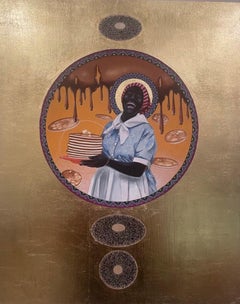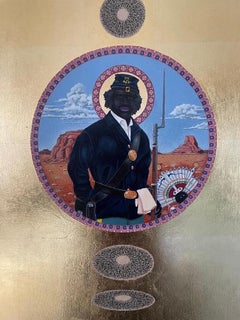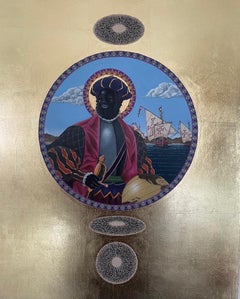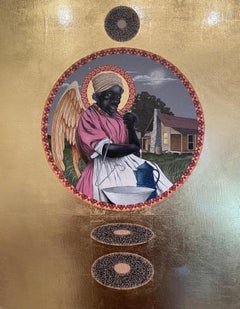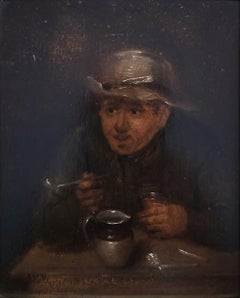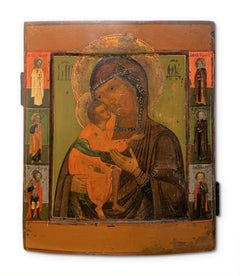Byzantine Paintings
to
3
11
10
1
1
19
2
9
8
1
1
2
Overall Height
to
Overall Width
to
45,633
37,021
19,064
7,853
3,448
3,019
2,949
2,282
1,257
1,207
1,183
1,181
450
224
16
11
11
6
5
4
2
2
2
2
1
1
1
1
1
1
1
1
1
1
12
8
1
1
10
8
21
19
17
17
12
Style: Byzantine
Centaur and a woman
By Alexis Gritchenko
Located in Bayonne, NJ
This is a very rare to find painting that was exhibited by Alexis Gritchenko at the Athens Museum of Byzantine Art in 1923. Originally, 36 encaustic on cardboard pieces from the Gree...
Category
1920s Byzantine Paintings
Materials
Gouache, Encaustic
Icon of Our Lady of Jerusalem with oklad by Oliver Samsinger
Located in Segovia, ES
Icon of Our Lady of Jerusalem.
Egg tempera on gesso and over a wooden board.
Dimensions in centimeters: 42 x 34 x 2 cm / In inches: 16.54 x 13-39 x 0-79 "
Author: Oliver Samsinger...
Category
1990s Byzantine Paintings
Materials
Brass
Ain't yo' Mama, Make yo' own Goddamn Pancakes
Located in Santa Monica, CA
Halo presents an amazing cast of historical black figures, most of whom were legendary and mythic characters in their time, but have been nearly lost to the vagaries and biases of hi...
Category
2010s Byzantine Paintings
Materials
Gold Leaf
Cathay Williams
Located in Santa Monica, CA
Halo presents an amazing cast of historical black figures, most of whom were legendary and mythic characters in their time, but have been nearly lost to the vagaries and biases of hi...
Category
2010s Byzantine Paintings
Materials
Gold Leaf
Lope Martin
Located in Santa Monica, CA
Halo presents an amazing cast of historical black figures, most of whom were legendary and mythic characters in their time, but have been nearly lost to the vagaries and biases of hi...
Category
2010s Byzantine Paintings
Materials
Gold Leaf
Letitia Munson
Located in Santa Monica, CA
Halo presents an amazing cast of historical black figures, most of whom were legendary and mythic characters in their time, but have been nearly lost to the vagaries and biases of hi...
Category
2010s Byzantine Paintings
Materials
Gold Leaf
Christ Pantocrator after an Russian icon of the 15th Century
Located in Segovia, ES
Christ Pantocrator after a Russian icon of the 15th Century.
Tempera and gold leaf on gesso over a wooden board.
Measurements in centimeters: 38 x 29.5 x 3 cm. / In inches: 14.96 x 11.8 x 1.18 "
This is how the artist sums up the technique used by him to create the icon:
“The aim of these steps is to create a durable painting. The icon is eternal.
The first step is to choose a support, traditionally made of wood, from the center of the trunk to avoid warping it. For this purpose, two hardwood bolts were often used on the back to give the picture panel additional stability.
Often a frame is milled out. Then the image carrier is sanded smooth and now 12 or 14 thin layers of gesso are applied and sanded smooth as well.
Then the preliminary drawing is applied and the drawing board is prepared with a special preparation called bolus. This bolus can be polished to a high gloss. Afterwards, the gold leaf is
"shot" with special brushes. It dries up within a few hours and can now be polished with agate. Gold leaf is real 24-carat gold.
Now does the actual process of painting begins. Egg tempera is made fresh from egg yolk, water, and a little vinegar. This is used to prepare the color pigments.
Tempera painting is done in numerous layers from dark to light.
When the icon is finished, it is left to dry for a few months and varnished with a special varnish called Olifa made from boiled linseed oil and other ingredients”.
ABOUT THE ARTIST
Oliver Samsinger (Vienna, 1968) began to take an interest in icons in 1990. He undertakes several trips to Bulgaria, Greece, and Cyprus to see in situ the original works treasured in these three countries. This experience will be crucial in his life since the studies carried out in Sofia, the Bulgarian capital, and his stay on Mount Athos...
Category
1990s Byzantine Paintings
Materials
Gold Leaf
Virgin of Kataphyge and St. John, after a Byzantine Bulgarian Icon 14th Century
Located in Segovia, ES
The Virgin of Kataphyge with Saint John the Evangelist, after a Bulgarian Byzantine icon of the 14th Century.
Egg tempera and gold leaf on gesso and wood.
Author: Oliver Samsinger...
Category
Early 1900s Byzantine Paintings
Materials
Gold Leaf
Christ, the Great High Priest. Greek-Italian style Icon with silver oklad
Located in Segovia, ES
Christ, the Great High Priest. Greek-Italian style Icon with silver filigreed oklad.
Egg tempera, over gesso on wood with a silver cover, "oklad", with pol...
Category
1990s Byzantine Paintings
Materials
Silver
'Christ Pantocrator with Mary & St. John', Theotokos, Greek Orthodox, Christian
Located in Santa Cruz, CA
A very substantial, early 19th century, oil-on-canvas laid down on panel showing a view of the risen Christ Pantocrator flanked by the Virgin Mary and St....
Category
Early 19th Century Byzantine Paintings
Materials
Gold Leaf
Christ Pantocrator" After an Icon in the style of the Moscow School
Located in Segovia, ES
"Christ Pantocrator". After an Icon in the style of the Moscow school (15th century). Somewhat similar to that of Rublev.
Author: Oliver Samsinguer
Egg tempera and gold leaf on gesso and on wood.
Dimensions; (H) 42 x (W) 33.5 x (D) 3.5 cm.
(H) 16.54 x (W) 13.19 x (D) 1.38 in.
This is how the artist sums up the technique used by him to create the icon:
“The aim of these steps is to create a durable painting. The icon is eternal.
The first step is to choose a support, traditionally made of wood, from the center of the trunk to avoid warping it. For this purpose, two hardwood bolts were often used on the back to give the picture panel additional stability.
Often a frame is milled out. Then the image carrier is sanded smooth and now 12 or 14 thin layers of gesso are applied and sanded smooth as well.
Then the preliminary drawing is applied and the drawing board is prepared with a special preparation called bolus. This bolus can be polished to a high gloss. Afterwards, the gold leaf is
"shot" with special brushes. It dries up within a few hours and can now be polished with an agate. Gold leaf is real 24-carat gold .
Now, the actual process of painting begins. Egg tempera is made fresh from egg yolk, water, and a little vinegar. This is used to prepare the color pigments.
Tempera painting is done in numerous layers from dark to light.
When the icon is finished, it is left to dry for a few months and varnished with a special varnish called Olifa made from boiled linseed oil and other ingredients”.
ABOUT THE ARTIST
Oliver Samsinger...
Category
1990s Byzantine Paintings
Materials
Gold Leaf
The Virgin of Tijvin (after a Russian Icon in the style of the 18th century).
Located in Segovia, ES
The Virgin of Tijvin (after a Russian icon in the style of the 18th Century).
Egg tempera and gold leaf on gesso over wood.
Measurements in centimeters: 45 x 36.5 x 3 cm / In inch...
Category
1990s Byzantine Paintings
Materials
Gold Leaf
Saint Nicolas in the style of Russian icons of the 18th century. With Oklad
Located in Segovia, ES
Icono of Saint Nicolas in the style of Russian icons of the 18th century.
Egg tempera and gesso on wood, covered by a metal oklad made by the artist himself. The oklad, in principle, were made to cover damaged parts of highly revered ancient icons...
Category
1990s Byzantine Paintings
Materials
Gesso, Wood, Egg Tempera
The Evangelist Matthew, after a Russian icon, school of Moscow, 15th century
Located in Segovia, ES
The Evangelist Mathew after a Russian Icon. School of Moscow, 15th century.
Egg tempera, gold leaf, and gesso, over a wooden board.
Dimensions: (H) 52 x (W) 36 x (D) 3 cm.
Saint Matthew, the Evangelist, is represented at his own desk, a true artisan laboratory.
THE THECHNIQUE
This is how the artist sums up the technique used by him to create the icon:
“The aim of these steps is to create a durable painting. The icon is eternal.
The first step is to choose a support, traditionally made of wood, from the center of the trunk to avoid warping it. For this purpose, two hardwood bolts were often used on the back to give the picture panel additional stability.
Often a frame is milled out. Then the image carrier is sanded smooth and now 12 or 14 thin layers of gesso are applied and sanded smooth as well.
Then the preliminary drawing is applied and the drawing board is prepared with a special preparation called bolus. This bolus can be polished to a high gloss. Afterwards, the gold leaf is
"shot" with special brushes. It dries up within a few hours and can now be polished with an agate. Gold leaf is real 24 carat gold .
Now does the actual process of painting begin. Egg tempera is made fresh from egg yolk, water and a little vinegar. This is used to prepare the color pigments.
Tempera painting is done in numerous layers from dark to light.
When the icon is finished, it is left to dry for a few months and varnished with a special varnish called Olifa made from boiled linseed oil and other ingredients”.
ABOUT THE ARTIST
Oliver Samsinger...
Category
1990s Byzantine Paintings
Materials
Gold Leaf
Saint John The Forerunner after a Russian Icon from the 16th Century
Located in Segovia, ES
Saint John, The Forerunner, after a Russian Icon from the 16th Century.
Tempera and gold leave on gesso over a wooden board.
Dimensions: (H) 33 x (W) 25,5 x (D) 4 cm.
John, The Forerunner, is depicted as an ascetic desert saint with a tousled beard and a coat made from camel hair. The expression that transmits his beautiful face is very intense.
This is how the artist sums up the technique used by him to create the icon:
“The aim of these steps is to create a durable painting. The icon is eternal.
The first step is to choose a support, traditionally made of wood, from the center of the trunk to avoid warping it. For this purpose, two hardwood bolts were often used on the back to give the picture panel additional stability.
Often a frame is milled out. Then the image carrier is sanded smooth and now 12 or 14 thin layers of gesso are applied and sanded smooth as well.
Then the preliminary drawing is applied and the drawing board is prepared with a special preparation called bolus. This bolus can be polished to a high gloss. Afterward, the gold leaf is
"shot" with special brushes. It dries up within a few hours and can now be polished with agate. Gold leaf is real 24-carat gold .
Now does the actual process of painting begins. Egg tempera is made fresh from egg yolk, water, and a little vinegar. This is used to prepare the color pigments.
Tempera painting is done in numerous layers from dark to light.
When the icon is finished, it is left to dry for a few months and varnished with a special varnish called Olifa made from boiled linseed oil and other ingredients”.
ABOUT THE ARTIST
Oliver Samsinger...
Category
1990s Byzantine Paintings
Materials
Gold Leaf
Virgin of Tijvin, after a Russian icon of the 17th Century.
Located in Segovia, ES
Virgin of Tijvin, after a Russian icon of the 17th century.
Egg tempera, gold leaf on gesso over a wooden board.
Measurements in centimeters: 44 x 33 x 3 cm / In inches: 17.32 x 12.99 x 1.18 "
Author: Oliver Samsinger...
Category
1990s Byzantine Paintings
Materials
Gold Leaf
"Birth of Christ" after a Russian icon of the 15th century. Oliver Samsinger
Located in Segovia, ES
"Birth of Christ", after a Russian icon of the 15th century.
Tempera and gold leaves on gesso, wooden board. Dimensions: (H) 68 x (W) 52 x (D) 4 cm.
This icon sums up the events of the birth of Christ. At the top left the three wise men from the Orient approach on horses.
ABOUT THE ARTIST
Oliver...
Category
1990s Byzantine Paintings
Materials
Gold Leaf
Califia
Located in Santa Monica, CA
Califia (c. 1510) is the mythical Black warrior Queen and inspiring character in Garci Rodríguez de Montalvo’s 16th century epic poem, Las Sergas de Esplandián (The Adventures of Esplandian). In Montalvo’s tale, Queen Califia rules on the fabled island of California, a utopia brimming with pearls and gold and inhabited solely by her menacing army of black Amazon women...
Category
2010s Byzantine Paintings
Materials
Gold Leaf
Zumbi dos Palmares
Located in Santa Monica, CA
Halo presents an amazing cast of historical black figures, most of whom were legendary and mythic characters in their time, but have been nearly lost to the vagaries and biases of history as seen through a white lens. With Halo, Greenfield brings the stories of Black folk-saints, martyrs, freedom-fighters, survivors, magicians, and visionaries back into view. Many of the figures are from the 1400-1800s, a timeframe that corresponds with Europeans beginning to use racial distinction as a tool to justify slavery. Greenfield honors their
simultaneously disturbing and astounding lives by bestowing them with halos, traditionally seen as reverential symbols of adoration and respect. “I am reimagining what a saint is,” Greenfield says. “Maybe in studying their stories, they can inform us on better ways to live.”
Thought to have been a descendent of central African royalty...
Category
2010s Byzantine Paintings
Materials
Gold Leaf
Solitude of Guadeloupe
Located in Santa Monica, CA
Halo presents an amazing cast of historical black figures, most of whom were legendary and mythic characters in their time, but have been nearly lost to the vagaries and biases of hi...
Category
2010s Byzantine Paintings
Materials
Gold Leaf
Balthazar
Located in Santa Monica, CA
One of the three biblical ‘magi’ or ‘wise men,’ King Balthazar gave the highly prized gift of liquid myrrh to Jesus upon his birth. Balthazar was an African King...
Category
2010s Byzantine Paintings
Materials
Gold Leaf
Related Items
Man in Tavern Smoking a Pipe /// Old Masters Dutch David Teniers Portrait Face
Located in Saint Augustine, FL
Artist: Unknown (Circle of David Teniers the Younger, Flemish, 1610-1690)
Title: "Man in Tavern Smoking a Pipe"
*No signature found
Circa: 1690
Medium: Original Oil Painting on Wooden Board
Framing: Framed in an antique gold gesso frame...
Category
1690s Byzantine Paintings
Materials
Gold Leaf
Madonna and Child
Located in Santa Fe, NM
This classic icon is beautifully painted with a rich patina and is in very good condition - checking all the boxes for a wonderful investment quality antique.
Since 1995, the Pushk...
Category
Late 19th Century Byzantine Paintings
Materials
Gold Leaf
Christ Pantocrator after an Russian icon of the 15th Century
Located in Segovia, ES
Christ Pantocrator after a Russian icon of the 15th Century.
Tempera and gold leaf on gesso over a wooden board.
Measurements in centimeters: 38 x 29.5 x 3 cm. / In inches: 14.96 x 11.8 x 1.18 "
This is how the artist sums up the technique used by him to create the icon:
“The aim of these steps is to create a durable painting. The icon is eternal.
The first step is to choose a support, traditionally made of wood, from the center of the trunk to avoid warping it. For this purpose, two hardwood bolts were often used on the back to give the picture panel additional stability.
Often a frame is milled out. Then the image carrier is sanded smooth and now 12 or 14 thin layers of gesso are applied and sanded smooth as well.
Then the preliminary drawing is applied and the drawing board is prepared with a special preparation called bolus. This bolus can be polished to a high gloss. Afterwards, the gold leaf is
"shot" with special brushes. It dries up within a few hours and can now be polished with agate. Gold leaf is real 24-carat gold.
Now does the actual process of painting begins. Egg tempera is made fresh from egg yolk, water, and a little vinegar. This is used to prepare the color pigments.
Tempera painting is done in numerous layers from dark to light.
When the icon is finished, it is left to dry for a few months and varnished with a special varnish called Olifa made from boiled linseed oil and other ingredients”.
ABOUT THE ARTIST
Oliver Samsinger (Vienna, 1968) began to take an interest in icons in 1990. He undertakes several trips to Bulgaria, Greece, and Cyprus to see in situ the original works treasured in these three countries. This experience will be crucial in his life since the studies carried out in Sofia, the Bulgarian capital, and his stay on Mount Athos...
Category
1990s Byzantine Paintings
Materials
Gold Leaf
H 14.97 in W 11.62 in D 1.19 in
Encaustic Icon Featuring Madonna and Child
Located in Larchmont, NY
Icon of Madonna and Child, Likely Byzantine, c. 1800
Encaustic on wood
12 1/4 x 10 1/4 x 1 1/2 in.
The word icon (from the Greek eikon, or image) signifies a holy image that provide...
Category
19th Century Byzantine Paintings
Materials
Gold Leaf
Virgin of Kataphyge and St. John, after a Byzantine Bulgarian Icon 14th Century
Located in Segovia, ES
The Virgin of Kataphyge with Saint John the Evangelist, after a Bulgarian Byzantine icon of the 14th Century.
Egg tempera and gold leaf on gesso and wood.
Author: Oliver Samsinger...
Category
Early 1900s Byzantine Paintings
Materials
Gold Leaf
H 15.36 in W 10.63 in D 0.99 in
Christ, the Great High Priest. Greek-Italian style Icon with silver oklad
Located in Segovia, ES
Christ, the Great High Priest. Greek-Italian style Icon with silver filigreed oklad.
Egg tempera, over gesso on wood with a silver cover, "oklad", with pol...
Category
1990s Byzantine Paintings
Materials
Silver
H 21.26 in W 15.36 in D 0.79 in
Encaustic Figurative 1960's Gloria Dudfield
Located in Arp, TX
Gloria Dudfield (1922 – 2015)
Untitled
c.1960's
Encaustic and charcoal on paper
16"x18"
Unsigned
Came from a portfolio of her work in the San Francisco Bay Area.
Gloria had a Mast...
Category
Mid-20th Century Byzantine Paintings
Materials
Encaustic, Gouache, Charcoal
The Evangelist Matthew, after a Russian icon, school of Moscow, 15th century
Located in Segovia, ES
The Evangelist Mathew after a Russian Icon. School of Moscow, 15th century.
Egg tempera, gold leaf, and gesso, over a wooden board.
Dimensions: (H) 52 x (W) 36 x (D) 3 cm.
Saint Matthew, the Evangelist, is represented at his own desk, a true artisan laboratory.
THE THECHNIQUE
This is how the artist sums up the technique used by him to create the icon:
“The aim of these steps is to create a durable painting. The icon is eternal.
The first step is to choose a support, traditionally made of wood, from the center of the trunk to avoid warping it. For this purpose, two hardwood bolts were often used on the back to give the picture panel additional stability.
Often a frame is milled out. Then the image carrier is sanded smooth and now 12 or 14 thin layers of gesso are applied and sanded smooth as well.
Then the preliminary drawing is applied and the drawing board is prepared with a special preparation called bolus. This bolus can be polished to a high gloss. Afterwards, the gold leaf is
"shot" with special brushes. It dries up within a few hours and can now be polished with an agate. Gold leaf is real 24 carat gold .
Now does the actual process of painting begin. Egg tempera is made fresh from egg yolk, water and a little vinegar. This is used to prepare the color pigments.
Tempera painting is done in numerous layers from dark to light.
When the icon is finished, it is left to dry for a few months and varnished with a special varnish called Olifa made from boiled linseed oil and other ingredients”.
ABOUT THE ARTIST
Oliver Samsinger...
Category
1990s Byzantine Paintings
Materials
Gold Leaf
H 20.48 in W 14.18 in D 1.19 in
Painted Wood Tavolette Book Cover Binding in the Biccherna Style Siena Tuscany
Located in Sutton Poyntz, Dorset
Icilio Federico Joni.
Italian ( b.1866 - d.1946 ).
Painted Gesso, Gilt and Wood Tavolette Book Cover Binding in the Sienese Biccherna Style
Book Cover size 11 inches x 8.1 inches ( 28cm x 20.5cm ).
Frame size 16 inches x 13 inches ( 40.5cm x 33cm ).
Available for sale; this painted gesso and gilt “tavolette” wooden book cover in the Biccherna style is by Icilio Federico Joni.
The book cover is mounted and supplied in a contemporary black Tulip Wood frame (which is shown in these photographs) which is glazed with non-reflective Tru Vue UltraVue® UV70 glass. The wooden book cover is curved and float mounted giving a wonderful 3D depth to its presentation.
The gesso and painted surfaces have benefitted from professional restoration which was performed on our instruction, supervision and approval.
This antique book cover is now in very good condition, commensurate with its age.
The frame presentation is new and in excellent condition. Combined, it wants for nothing and is supplied ready to hang and display.
The story of these panels and of their artist is fascinating, and begins in 13th century Siena:
The Biccherna was the person who held the position of Magistrate of Chancellery of Finance from the 13th to the 14th century for the republic and the city of Siena, in the Tuscany region of Italy. The records of that office were very important because Siena was one of the earliest and most significant banking centres in Italy, and indeed in Europe. It became the fashion to keep banking and taxation records of the region in large books with painted leather covers. These were originally made from wood and leather. In the competition to make these ever more prestigious the bindings and panels on the front and rear of the books were painted by the major artists of the day, such as Giovanni di Paolo. Many of these mainly secular covers are displayed in the Archives of the State of Siena located in the Palazzo Piccolmini.
The Gothic Revival of the 19th century occurred partly as a reaction against the progress of industrialisation in Europe generally. It was however greatly affected by the unification of Italy in the second half of the 19th century. This led to the closure and downsizing of many religious institutions, which resulted in the dispersal of thousands of works of art dating from the Middle Ages and early Renaissance. Many aristocratic and bourgeois families struggled to pay debts or simply to make ends meet and so they sold off their private collections and family heirlooms. There was then an influx of goods into the antiques market which provided a great deal of work for Italy’s restorers and craftsmen, since many of these pieces were in need of cleaning, repair and, in keeping with the interventionist tastes of the times, radical restoration, before they could be sold on, often to foreign buyers. These early Italian works became so fashionable that demand soon outstripped supply. This in turn gave rise to a new type of artist-craftsman capable of turning out from scratch increasingly convincing reproductions, imitations and out-and-out fakes.
Siena naturally became the epicentre of this thriving cottage industry because of the extraordinary continuity there in traditional craft skills. This technical expertise had been handed down from generation to generation, and it was perhaps inevitable that a number of artists with real talent, the flair of commerce and a genuine love and understanding of antique Sienese art should adapt their skills to these new market conditions. Among these artists were Igino Gottardi, Alceo Dossena, Fulvio Corsini, Umberto Giunti...
Category
Late 19th Century Byzantine Paintings
Materials
Gesso, Oil, Tempera, Wood Panel
H 15.95 in W 13 in D 1.97 in
Saint John The Forerunner after a Russian Icon from the 16th Century
Located in Segovia, ES
Saint John, The Forerunner, after a Russian Icon from the 16th Century.
Tempera and gold leave on gesso over a wooden board.
Dimensions: (H) 33 x (W) 25,5 x (D) 4 cm.
John, The Forerunner, is depicted as an ascetic desert saint with a tousled beard and a coat made from camel hair. The expression that transmits his beautiful face is very intense.
This is how the artist sums up the technique used by him to create the icon:
“The aim of these steps is to create a durable painting. The icon is eternal.
The first step is to choose a support, traditionally made of wood, from the center of the trunk to avoid warping it. For this purpose, two hardwood bolts were often used on the back to give the picture panel additional stability.
Often a frame is milled out. Then the image carrier is sanded smooth and now 12 or 14 thin layers of gesso are applied and sanded smooth as well.
Then the preliminary drawing is applied and the drawing board is prepared with a special preparation called bolus. This bolus can be polished to a high gloss. Afterward, the gold leaf is
"shot" with special brushes. It dries up within a few hours and can now be polished with agate. Gold leaf is real 24-carat gold .
Now does the actual process of painting begins. Egg tempera is made fresh from egg yolk, water, and a little vinegar. This is used to prepare the color pigments.
Tempera painting is done in numerous layers from dark to light.
When the icon is finished, it is left to dry for a few months and varnished with a special varnish called Olifa made from boiled linseed oil and other ingredients”.
ABOUT THE ARTIST
Oliver Samsinger...
Category
1990s Byzantine Paintings
Materials
Gold Leaf
H 13 in W 10.04 in D 1.58 in
Christ Pantocrator" After an Icon in the style of the Moscow School
Located in Segovia, ES
"Christ Pantocrator". After an Icon in the style of the Moscow school (15th century). Somewhat similar to that of Rublev.
Author: Oliver Samsinguer
Egg tempera and gold leaf on gesso and on wood.
Dimensions; (H) 42 x (W) 33.5 x (D) 3.5 cm.
(H) 16.54 x (W) 13.19 x (D) 1.38 in.
This is how the artist sums up the technique used by him to create the icon:
“The aim of these steps is to create a durable painting. The icon is eternal.
The first step is to choose a support, traditionally made of wood, from the center of the trunk to avoid warping it. For this purpose, two hardwood bolts were often used on the back to give the picture panel additional stability.
Often a frame is milled out. Then the image carrier is sanded smooth and now 12 or 14 thin layers of gesso are applied and sanded smooth as well.
Then the preliminary drawing is applied and the drawing board is prepared with a special preparation called bolus. This bolus can be polished to a high gloss. Afterwards, the gold leaf is
"shot" with special brushes. It dries up within a few hours and can now be polished with an agate. Gold leaf is real 24-carat gold .
Now, the actual process of painting begins. Egg tempera is made fresh from egg yolk, water, and a little vinegar. This is used to prepare the color pigments.
Tempera painting is done in numerous layers from dark to light.
When the icon is finished, it is left to dry for a few months and varnished with a special varnish called Olifa made from boiled linseed oil and other ingredients”.
ABOUT THE ARTIST
Oliver Samsinger...
Category
1990s Byzantine Paintings
Materials
Gold Leaf
H 16.54 in W 13.19 in D 1.38 in
Gotich style Florentine painter - 19th century figure painting - Virgin Child -
Located in Varmo, IT
Florentine painter (19th century) - Madonna with Child on a gold background.
77 x 58 cm.
Oil on polylobed panel.
Condition report: Good state of conservation of the pictorial surf...
Category
Late 19th Century Byzantine Paintings
Materials
Oil, Panel
Previously Available Items
Veneto-Cretan school. Late XVI cent. Madonna with child and Saint James- Pilgrim
Located in Firenze, IT
Madonna with Child and Saint James as a Pilgrim, painted on wood panel, Veneto-Cretan school, from the late 16th-early 17th century.
Saint James is recognizable by the typical attributes of pilgrims, depicted with a pilgrim’s staff in hand. On his chest, the saint wears a scallop shell, adorned with a simple and modest traveler’s attire, and embroidered keys on his garment.
The Madonna with Child are depicted following the iconography of Byzantine icons.
Size: H 32cm x 28,5cm
This small spruce panel typical of paintings from this school, was created by a painter of Greek or rather Byzantine origins.
These spruce panels are products of the Veneto region, sourced from forests north of Venice. Wood panels made of spruce and other coniferous trees were supplied to painters on the islands by Venetian merchants...
Category
18th Century and Earlier Byzantine Paintings
Materials
Oil, Board
Free Shipping
H 12.6 in W 11.23 in D 1.58 in
The Holy Trinity II, after an icon by Russian painter Rublev (15th century)
Located in Segovia, ES
The Holy Trinity II, after an icon created by Russian painter Andrei Rublev in the 15th century. It is his most famous work and the most famous of all Russian icons.
Measurements in ...
Category
1990s Byzantine Paintings
Materials
Gold Leaf
H 28.75 in W 25.6 in D 1.58 in
The Holy Trinity, after an icon by Russian painter Andrei Rublev (15th century)
Located in Segovia, ES
The Holy Trinity, after an icon created by Russian painter Andrei Rublev in the 15th century. It is his most famous work and the most famous of all Russi...
Category
1990s Byzantine Paintings
Materials
Gold
The Annuntiation (after an ancient Byzantine Icon).
Located in Segovia, ES
The Annuntiation (after an ancient Byzantine Icon)
Tempera egg and golg leaf on gesso over wood.
Dimensions: (H) 61 x (W) 51 x (D) 2.5 cm / In inches: (H) 24.02 x (W) 20.08 x (D) 0.98 "
Weight: 4.2 Kg.
Author: Oliver Samsinger...
Category
1990s Byzantine Paintings
Materials
Gold Leaf
Rebecca Cox Jackson
Located in Santa Monica, CA
Halo presents an amazing cast of historical black figures, most of whom were legendary and mythic characters in their time, but have been nearly lost to the vagaries and biases of hi...
Category
2010s Byzantine Paintings
Materials
Gold Leaf
Marie-Joseph Angelique
Located in Santa Monica, CA
Halo presents an amazing cast of historical black figures, most of whom were legendary and mythic characters in their time, but have been nearly lost to the vagaries and biases of hi...
Category
2010s Byzantine Paintings
Materials
Gold Leaf
Saint John the Baptist,
Located in Segovia, ES
Saint John the Baptist, after a Russian icon from the 16th century by Oliver Samsinger.
Egg tempera and gold leaf on gesso over a woodern board....
Category
1990s Byzantine Paintings
Materials
Gold Leaf
Christ Pantocrator, after a Russian icon of Andrei Rublev from the 14th century
Located in Segovia, ES
"Christ Pantocrator" after a Russian icon of Andrei Rublev from the 14th century.
Egg tempera and gold leaf on gesso over a wooden board.
Dimensions: (...
Category
1990s Byzantine Paintings
Materials
Gold Leaf
H 19.3 in W 14.57 in D 1.19 in
Antique Greek Orthodox 17thCentury Icon Gilded Egg Tempera Saint Athanasios 1650
Located in Portland, OR
A fine & rare 17th century Greek Orthodox Icon, Saint Athanasios (Athanasius), circa 1650.
The icon depicting Saint Athanasios enthroned in the By...
Category
17th Century Byzantine Paintings
Materials
Egg Tempera
H 21.5 in W 18.5 in D 2.25 in
Iznik Jar
By Sarah Warren
Located in London, GB
This exquisite painting of an Islamic decorative jar is based from a historical object from 1550 found in the British Museum. The shape of this jar i...
Category
2010s Byzantine Paintings
Materials
Acrylic
Antique Greek Orthodox 17thCentury Icon Gilded Egg Tempera Christ Enthroned 1650
Located in Portland, OR
A fine & rare 17th century Greek Orthodox Icon, "Christ Enthroned", circa 1650.
The icon depicting Christ enthroned in the Byzantine style and pain...
Category
17th Century Byzantine Paintings
Materials
Egg Tempera
H 21.5 in W 18.5 in D 2.25 in
19th Century Greek School Icon - Religious Scene - Oil on Large Wood Panel
Located in Cirencester, Gloucestershire
Artist/ School: Greek School, 19th century, inscribed/ signed
Title: Religious scene icon
Medium: oil painting on wooden panel, unframed
Size: panel: 2...
Category
19th Century Byzantine Paintings
Materials
Oil, Wood Panel
H 23 in W 27.5 in D 1 in
Byzantine paintings for sale on 1stDibs.
Find a wide variety of authentic Byzantine paintings available for sale on 1stDibs. Works in this style were very popular during the 21st Century and Contemporary, but contemporary artists have continued to produce works inspired by this movement. Many Pop art paintings were created by popular artists on 1stDibs, including Mark Steven Greenfield, Anastasia Kurakina, and Sax Berlin. Frequently made by artists working with Paint, and Metal and other materials, all of these pieces for sale are unique and have attracted attention over the years. Not every interior allows for large Byzantine paintings, so small editions measuring 7.87 inches across are also available. Prices for paintings made by famous or emerging artists can differ depending on medium, time period and other attributes. On 1stDibs, the price for these items starts at $1,046 and tops out at $35,000, while the average work sells for $3,186.
Recently Viewed
View AllMore Ways To Browse
Advertising Box
Great Race
House And Garden Book Of
Fells House
C Raymond
Religious Icon
W S George
Early 19th Century Portrait French
Candy Pink
Large Baroque Painting
Original Painting Book Cover
Oriental Vintage Painting
Mary Child
Child Mary
Tiger Canvas
Used Book Search
Religious Paintings On Wood
Constant George

